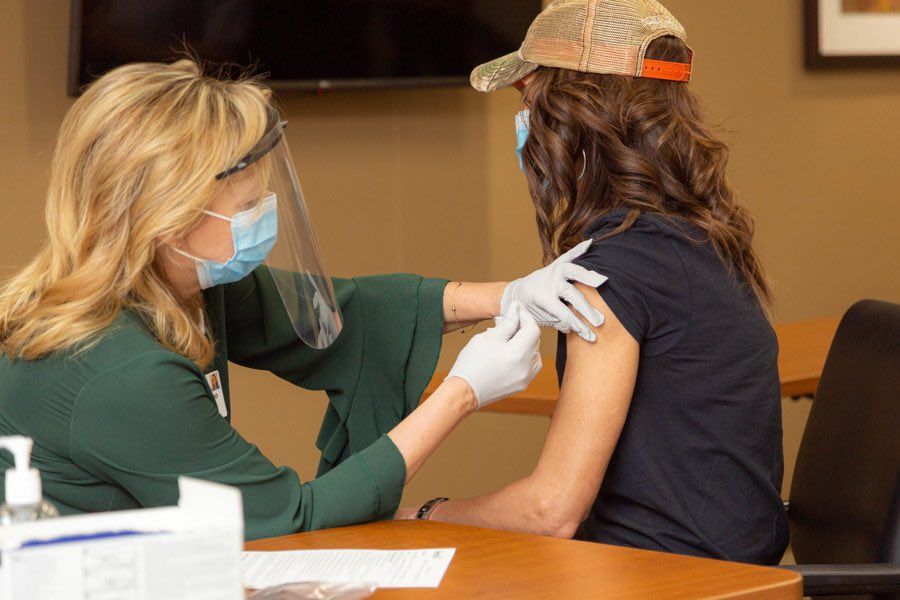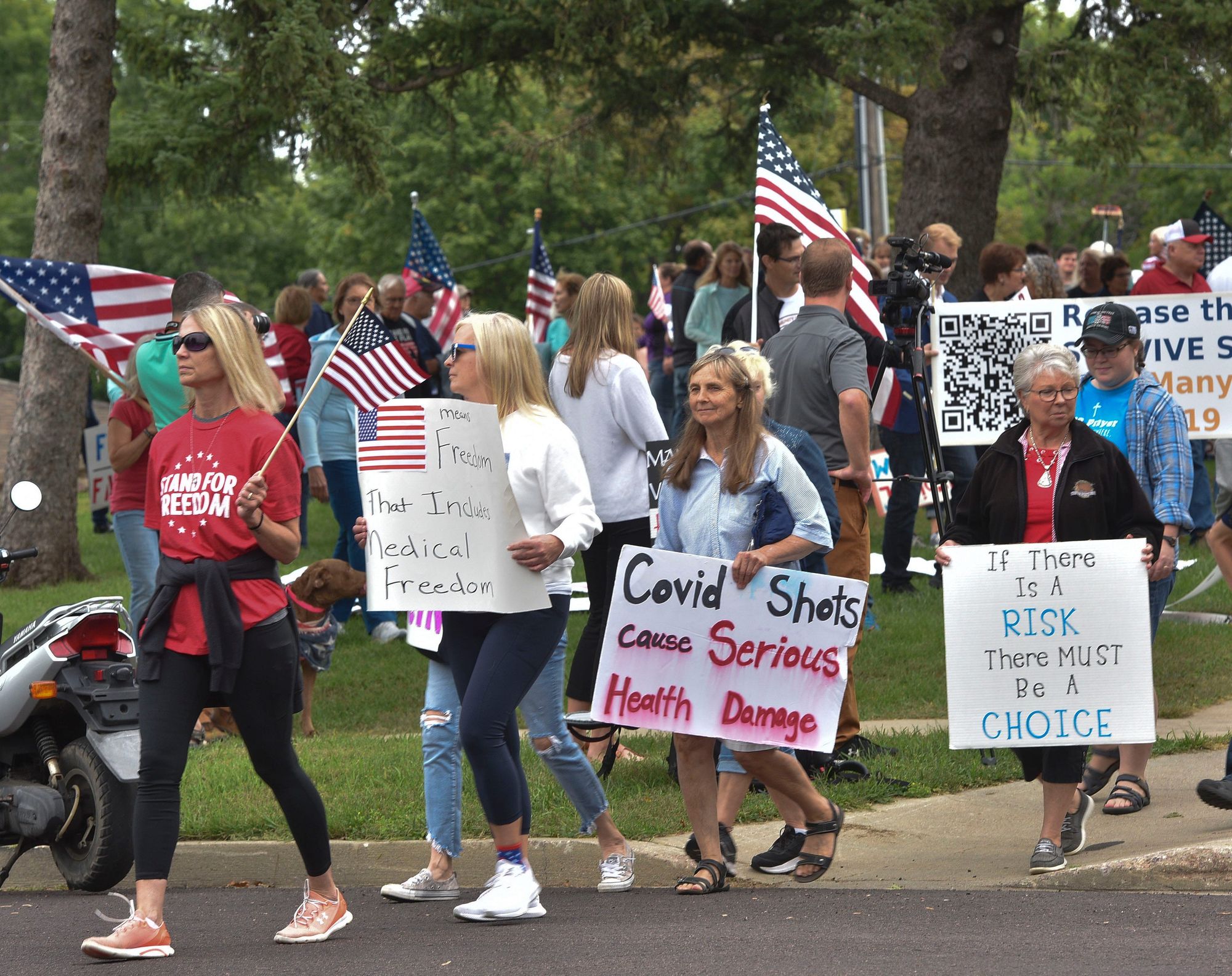Even as COVID-19 infections and deaths are rising once again in South Dakota, resistance to getting vaccinated remains entrenched among some state residents, and the political divide over whether to get vaccinated shows no signs of narrowing.
Two new sets of polling data on vaccine-hesitancy rates and reasons have raised concerns of health and medical professionals in South Dakota who see widespread vaccination against COVID-19 as the only way to reduce hospitalizations and deaths and forge a path to a return to normalcy.
A statewide poll conducted by South Dakota State University researchers in late July and early August showed that 65% of unvaccinated respondents were “very unlikely” to get vaccinated against COVID-19 and that another 16% were “somewhat unlikely” to get the shots. Less than 1% of unvaccinated respondents said they were “very likely” to get vaccinated in the future.
That same poll showed that while 87% of Democrats said they were vaccinated, only 61% of Independents and 46% of Republicans were vaccinated, a troubling trend in a state dominated by GOP voters and elected officials.
Meanwhile, a new national review of statewide polling data on vaccine hesitancy showed that South Dakota has a higher-than-average rate of residents who oppose vaccinations because they don’t think the vaccines are needed, because they don’t trust the vaccines or government, or because they don’t see COVID-19 as a big threat.
A series of recent SDSU polls have consistently shown that state residents of both political parties, especially Republicans, have aligned their views with messaging from national and state party leaders on major issues such as taxes, welfare, foreign policy and now the COVID-19 vaccines and masking, said Filip Viskupic, an SDSU political science professor who helped design the most recent poll.
“It’s remarkable how this issue has gone from a medical or public-health issue and is now seen through a political lens,” Viskupic said.
Prior SDSU Poll results show that when it comes to pandemic-related issues, Democrats in South Dakota have indicated high trust in science and scientists, including Dr. Anthony Fauci and the Centers for Disease Control and Prevention, while Republicans have adopted views more closely aligned with Republican Party leaders, some of whom have resisted mask and vaccine mandates and expressed lukewarm or no support for widespread vaccination against COVID-19.
Political divide and vaccine hesitancy
Results from a statewide poll of 573 registered voters in South Dakota in late July and early August reveal that political party affiliation has a strong relationship with willingness to get vaccinated against COVID-19, and also that unvaccinated residents appear unlikely to get the shots anytime soon.
Political divide
— 87% of Democrats vaccinated
— 61% of Independents vaccinated
— 46% of Republicans vaccinated
— 83% of Democrats “somewhat or very supportive” of vaccine passports
— 75% of Republicans “somewhat or strongly opposed” to vaccine passports
Among unvaccinated respondents
— 65% “very unlikely” to get vaccinated
— 16% “somewhat unlikely” to get vaccinated
— 7% “somewhat likely” to get vaccinated
— Less than 1% “very likely” to get vaccinated
— 11% unsure
Source: SDSU Poll; error margin is plus/minus 4%
The split in support of vaccines between Democrats and Republicans in South Dakota does not bode well for health officials who are trying to reach herd immunity in a GOP-dominated state, Viskupic said. Herd immunity is the condition where enough members of a population are vaccinated or have obtained immunity after being infected so as to greatly limit spread of a virus.
“It does not make the jobs of doctors or public-health officials easier,” Viskupic said. “That is definitely a concern from the public-health perspective because the goal is to have 70 or 80 percent of us vaccinated to reach herd immunity and bring the pandemic under control.”
One national data analyst who has tracked vaccine-hesitancy poll results across the country for months said resistance to the COVID-19 vaccines has been higher in states where political leaders have expressed doubt about vaccines or presented mixed messages to the public.
Data analyst Nick VinZant said recent U.S. Census Household Pulse Survey data has consistently shown a high level of vaccine hesitancy in South Dakota compared with the rest of the nation, and noted that resistance to the vaccines has appeared to “harden” in recent months in the Rushmore State.
VinZant, an analyst with QuoteWizard, a firm that provides research to insurance companies, also noted that South Dakotans have a higher-than-average percentage of poll respondents who say their vaccine hesitancy is because they don’t see COVID-19 as a threat, don’t think the vaccines are necessary, or because they don’t trust the government. All three of those lines of reasoning showed statistically significant levels of increase over the past month or so, according to the polling data.
VinZant said it is possible that Gov. Kristi Noem’s consistent rhetoric opposing COVID-19 vaccine mandates has fueled hesitancy and distrust of the vaccines in South Dakota.
“The messages that are coming from politicians are absolutely a factor in people’s vaccine hesitancy and you can see that in South Dakota,” VinZant said. “We definitely see that hesitancy rise in states where messaging from politicians is that the coronavirus is not a big deal, and we see that reflected in the answers that people give about why they are not getting vaccinated.”
Ian Fury, spokesperson for Noem, said the Republican governor received the Pfizer vaccine regimen soon after it became available and has supported widespread vaccination of South Dakotans. In April, the governor posted a photo of herself receiving her first dose of the vaccine on Twitter.
But Noem, who has resisted COVID-19 restrictions on businesses and events such as the Sturgis motorcycle rally, has been highly vocal on social media and on national television in opposition to vaccine mandates. Noem in April issued an executive order banning “vaccine passports” in South Dakota, and continues to decry vaccine mandates. In early September, she threatened to sue the federal government after President Joe Biden announced a plan to force large employers to require employees to be vaccinated, and she appeared on the national Fox program “Hannity” to explain her position.

Fury did not respond to a list of specific questions sent to the governor’s office by News Watch, but did reply with this statement: “Gov. Noem is vaccinated and has encouraged South Dakotans to choose to get vaccinated as well. The governor is keeping her campaign promise of standing up to federal overreach. The Biden Administration does not have the authority to put forward the kind of mandates that they are proposing.”
Resistance to vaccination has not only allowed COVID-19 to spread more readily among adults and children, but has also opened the door to the emergence of coronavirus mutations such as the delta variant, a more transmissible form of the virus that is now the dominant strain in South Dakota, according to Dr. Shankar Kurra, vice president of medical affairs at Monument Health in Rapid City.
The longer and more frequently a virus spreads, the more likely it is to develop new strains that may be more resistant to current vaccination regimens, Kurra said.

Kurra said the delta variant has raised the level of vaccinations needed to reach herd immunity because it is so highly transmissible.
The original coronavirus strain, the alpha variant, was transmissible from one person to two others, Kurra said. The measles virus is the most highly transmissible illness, with one person able to infect 15 others. The delta variant of coronavirus is closer to the transmission rate of the chicken pox virus, enabling one person to spread the virus to as many as nine other people.
The increased opportunity for spread of the delta variant has pushed the vaccination percentage of the population to reach herd immunity from about 70% for the original coronavirus to as much as 85% or 90% of the population for the delta variant, Kurra said.
“If we don’t do the right thing and get that number [of vaccinations] up really quickly, we can expect more variants because this is the nature of this virus, the evolutionary nature of this virus,” he said.
Part of the divide in support for vaccinations in South Dakota and across the country is due to the rise of identity politics, in which segments of a population coalesce in groups that think alike and strengthen their views on important issues by sharing opinions rather than analyzing facts and data, Kurra said. The rise of identity politics is common in Western civilizations throughout history but often leads to disastrous results, he said.
“Rather than understanding issues, which is very difficult and nuanced, because every issue is super-nuanced, identity politics is aligning with a certain group and thoughts, and that is the bane of democracy,” Kurra said. “Healthy democracies require going away from identity politics and moving toward understand issues, which means education.”

Kurra has sought to break down identity politics among the roughly 5,000 employees of Monument Health by holding regular informational sessions where he presents scientific evidence on COVID-19, infection prevention and vaccine efficacy, and allows time for questions.
Dr. Jeremy Cauwels, chief physician at Sanford Health in Sioux Falls, said patient data show that COVID-19 remains “a pandemic of the unvaccinated” in the Great Plains and Midwest, where Sanford operates 46 hospitals in 10 states.
Of the roughly 145 patients hospitalized with COVID-19 across the Sanford system in early September, only 11 were fully vaccinated and most of those “breakthrough” patients were elderly or had co-morbidities that made them more susceptible to complications from the virus, Cauwels said.

The age of patients hospitalized with COVID-19 has fallen throughout 2021 as vaccinations have risen among older people and vaccine hesitancy has remained present among many younger adults, Cauwels said.
“Right now, the virus is attacking younger, healthier individuals who have chosen not to or are unable to get vaccinated,” he said.
Like other health and medical professionals, Cauwels places much of the blame for vaccine hesitancy on misinformation spread on social media, untrustworthy news outlets and a political divide in the U.S. that has led to entrenchment of binary views among many in the country on numerous issues, including vaccines.
“I think it absolutely has become political,” Cauwels said. “The fact that the information sources out there that are trusted are not the only thing being relied upon, that has caused a great deal of difficulty in understanding how this vaccine works, how safe it is and the good it can do for the people who can still get it.”
But Cauwels also acknowledges his disappointment that the American medical and health communities have not done as well as they could in promoting the safety and efficacy of the COVID-19 vaccines. Cauwels said hesitancy and outright disdain for vaccines was not present when the U.S. embarked on successful campaigns to vaccinate people against polio or immunize children against measles, mumps or rubella.
“It makes me sad … because that means that somewhere along the line we didn’t do a good job of messaging this,” he said. “It really, to me, is sort of sobering that we have a very effective vaccine or cure for it, and we have people out there who are absolutely afraid or unwilling to get the vaccine.”
Dr. David Basel, vice president of clinical quality for the Avera Medical Group in Sioux Falls, said he has seen a recent rise in interest in getting vaccinated among South Dakotans, likely driven by the rise in cases due to the delta variant.
He likened the effort to combat vaccine hesitancy to how the medical community successfully promoted smoking cessation — through a clear, consistent message delivered over a long period of time. But Basel said some vaccine-hesitant people may need to see a close friend or relative get sick or die from COVID-19 to spur them to get vaccinated.
Polling data is useful because it can help health officials and the medical community understand the reasons why people are hesitant to get vaccinated, and then to address those issues in a clear and forthright manner, Basel said. He said it is important to “meet people where they are at” in terms of understanding why someone is opposed to vaccination and making more direct personal connections and presenting consistent public messaging.
“We want to understand what their hesitations are so we can give them what they’re looking for in terms of what the data shows,” Basel said.
Enhancing efforts to make it easy for people to get vaccinated in as many physical locations as possible is another strategy that may increase vaccinations, Basel said.
Reasons for vaccine hesitancy
A recent analysis of polls results compiled by the U.S. Census Bureau through its Household Pulse Survey provides reasons for why residents of South Dakota and the nation as a whole are resistant to getting vaccinated against COVID-19. The data below show percentage of respondents who gave each reason in September, followed by the rise or fall in responses compared to the same survey in August.
South Dakota respondents
Side effect concerns — 59%, up 9%
Don’t think vaccine needed — 30%, up 11%
Plan to wait and see — 29%, down 1%
Don’t trust covid vaccines — 46%, down 2%
Don’t trust the government — 45%, up 12%
Don’t see covid as big threat — 29%, up 9%
United States respondents
Side effect concerns— 56%, up 1%
Don’t think vaccine needed — 28%, up 2%
Plan to wait and see — 37%, down 7%
Don’t trust covid vaccines — 44%, up 6%
Source: QuoteWizard analysis of U.S. Census data; totals do not add up to 100% because respondents could list more than one reason.
The state has taken an active role in promoting COVID-19 prevention, testing and vaccination, said Daniel Bucheli, a spokesman for the Department of Health.
DOH has done extensive messaging in support of vaccinations through traditional media including newspapers, television and radio as well as on social media including Facebook, Twitter and Google, Bucheli said.
One goal of the DOH has been to engage in “myth busting” to shoot down false narratives about the COVID-19 vaccines, including misinformation that vaccines contain the live coronavirus, that side effects are common and that vaccines alter a person’s DNA.
“We’ve found that providing clear, concise, and coherent information to individuals when they are choosing whether to get vaccinated is the best way forward,” Bucheli wrote to News Watch in an email. “This is a personal decision, and our job is to provide them with the best health data available.”
Unlike some states that have offered money, lottery payouts, college-tuition assistance or other inducements to encourage vaccinations, Bucheli said that “South Dakota does not plan to announce any incentives.”
Kurra said he takes heart in the SDSU polling data showing that while 65% of unvaccinated South Dakotans are “very unlikely” to get vaccinated, the remaining 35% can possibly be convinced to get vaccinated.
An SDSU poll in early 2021 also pointed to clergy and religious leaders as having strong influence on the views of South Dakotans regarding the pandemic.
Kurra said the medical community, especially individual hospital employees and physicians, can be a critical conduit to reaching and educating vaccine-hesitant people because they are trusted and have a close connection to individual patients. In addition to employee education sessions, Kurra has made himself very accessible to news outlets in order to share facts and the science behind COVID-19 prevention.
Kurra called the coronavirus pandemic the “worst in 100 years” and said there is no way out other than through widespread vaccinations.
“This is preventable, and we’ve got a solution and it’s called a vaccine, and it is critical we get to some high level of saturation of vaccinated population,” Kurra said. “It really is a dangerous option to not be vaccinated, because you are staking the potential on the one hand for a good, healthy life and on the other hand living a life that is full of morbidity and frequent visits to the hospital.”



